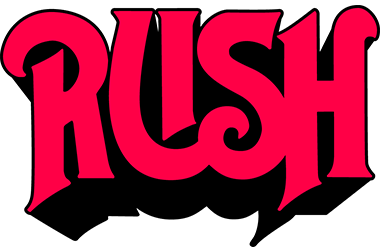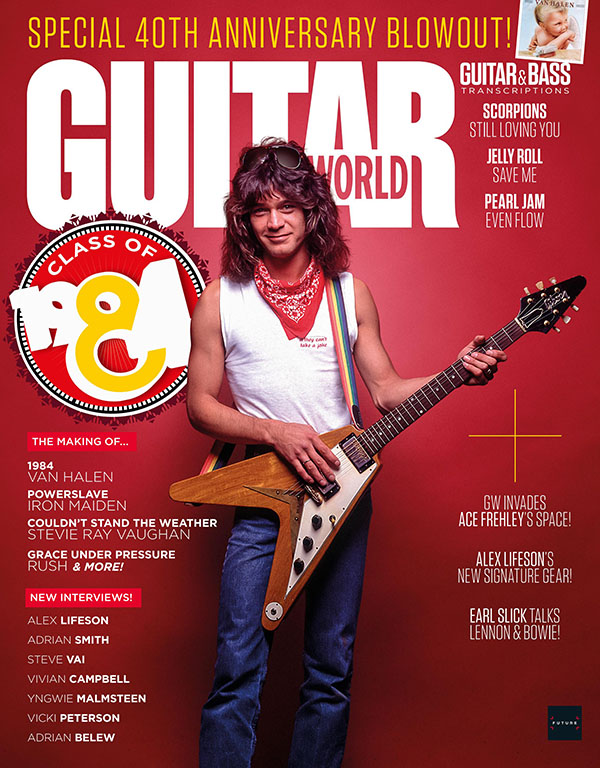
|
Guitar World Magazine May 2024 Volume 45, No. 5 STORY BY RICHARD BIENSTOCK PHOTOS BY RICHARD SIBBALD |
Limelight guitar (which is based on his original Hentor Sportscaster)
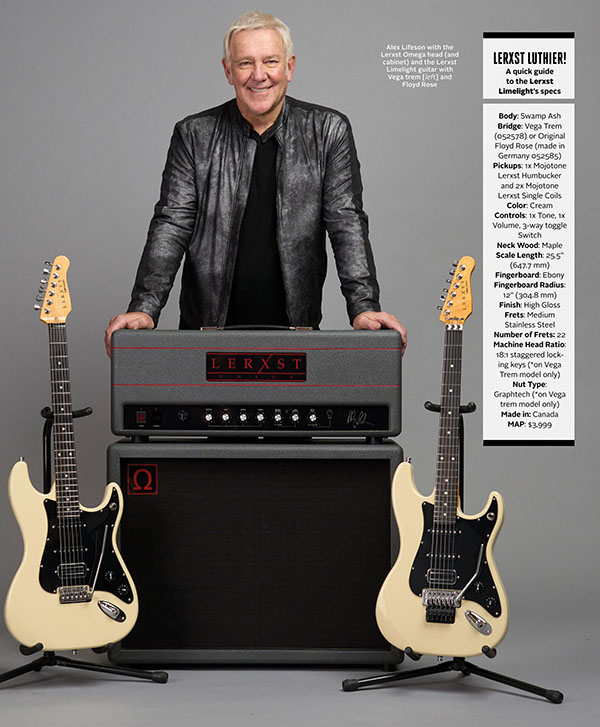
IF, SOMEWHERE OUT in the cosmos,
there exists a master list of guitarists
with the most coveted tones
in rock history, it’s safe to say that
Rush’s Alex Lifeson ranks near the
top. His sound — crisp and articulate,
and characterized by lightly chorused
arpeggios, shimmering, glassy chords
and smoothly overdriven lead lines —
has powered some of the greatest radio
anthems of the last half-century and is
instantly recognizable to generations of
listeners.
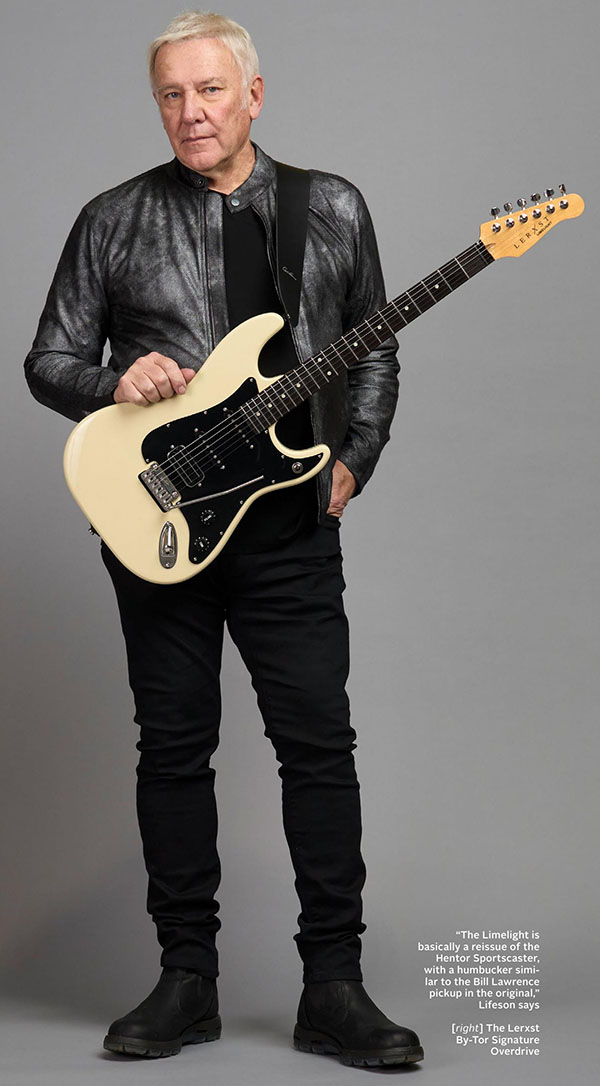
Lifeson has, unsurprisingly, collaborated
with various manufacturers on
signature pieces of gear over the years —
but never to the extent that he is at this
moment in time. Though Rush ceased
activity in 2015 (and, with the tragic
passing of drummer Neil Peart in 2020,
are unlikely to restart in the future) the
guitarist, now 70, is still deeply engaged
in his tone journey. To that end, he
recently unveiled a newly designed line
of high-end amplifiers under the brand
name Lerxst (Lifeson’s longtime nickname),
conceived and constructed in
partnership with celebrated North Carolina-
based manufacturer Mojotone.
The flagship design, the Omega, is based
on a custom model Mojotone built for
Lifeson during the run for Rush’s final
studio album, 2012’s Clockwork Angels.
The new Omega, a British-voiced head
with footswitch-able clean and lead
channels, a shared three-band EQ, a
switchable 50/25-watt power section
and a high-quality serial effects loop,
homes in on some of the key aspects of
Lifeson’s sound and brings them to the
public in a handsome (dig the “Starman”
power indicator light on the front panel,
for one eye-catching feature), handbuilt
package. “It’s a great amp,” Lifeson
tells Guitar World, “and I just thought,
now’s the time to share it.”
Lifeson is apparently in a very sharing
mood these days. In addition to the
Omega (also offered in a special-edition
hand-wired version), the Lerxst range
includes the Chi amplifier, a more compact
30-watt design available in smallbox
head and 1x12 combo formats, as
well as a variety of 1x12, 2x12 and 4x12
speaker cabinets. There’s also a Lerxst
pedal, the By-Tor Signature Overdrive,
which squeezes the sound and presence
of the Omega into an even smaller enclosure
— this one a ’board-friendly (note
the top-mounted jacks) stompbox with
discrete boost and drive sections that
can be engaged separately or in tandem.
But that’s not all. Not long after
announcing the joint venture with Mojotone,
Lifeson unveiled one more collaboration:
the Lerxst Limelight guitar,
designed in conjunction with Canadian
builder Godin. The first entry in a proposed
line of six-strings, the model draws
inspiration from one of Lifeson’s most
iconic and idiosyncratic instruments — the
heavily modded guitar known as the Hentor
Sportscaster, which Lifeson first used
on Rush’s smash 1981 album Moving Pictures
(it’s featured on the solo for “Limelight,”
among other tracks), and employed
significantly on the follow-ups, Signals
and Grace Under Pressure. The Hentor
began life as a Seventies-era Fender Stratocaster,
which Lifeson modified to meet
his specific tonal and playability needs,
eventually adding a Bill Lawrence L500
humbucker in the bridge position to access
heavier sounds, a more comfortable aftermarket
neck from a Canadian company
named Shark, a Floyd Rose tremolo and a
Gibson-style three-way toggle selector on
the lower horn, among other features. The
new Limelight guitar pays tribute to the
Hentor with an S-type swamp ash body,
customized maple neck, Lerxst Limelight
pickups in an HSS configuration, a threeway
toggle switch, the option of either a
Vega or Floyd Rose tremolo and more.
“I was a little apprehensive that it
wouldn’t come out the way I expected,”
Lifeson says of attempting to capture the
magic of such a unique instrument. “But
they nailed it.”
He laughs. “I mean, I’m biased, but it’s
really great.”
Lifeson recently sat down with Guitar
World to discuss his deep dive into signature
gear. But he also assured us that he
still enjoys making music with that gear
as well. “I’m writing and recording all
the time, I’m working on a lot of different
acts, I’m very, very happy being at home
and working on that stuff,” he says. As for
whether any of the “stuff” he’s working
on might one day include Rush bassist and
singer Geddy Lee? “We talk about it,” Lifeson
acknowledges. “But he’s got a busy
life. I’m doing things. So we’ll see how it
goes over the next little while.”
Until then, there’s plenty of new guitars,
amps and pedals to attend to. “Oh,
there’s lots of different things going on,”
Lifeson says. “It’s all been in the works
for a couple of years, and now it’s finally
arrived. And it’s so fun to get to this point.”
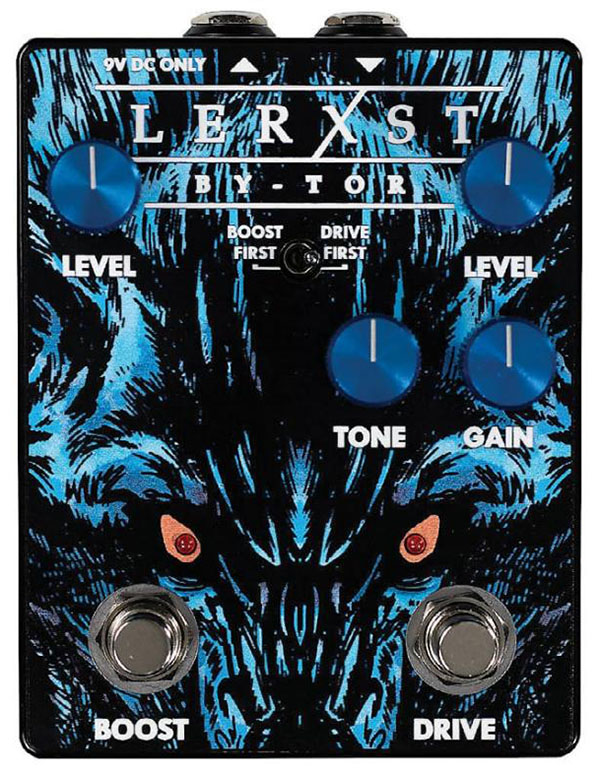 What led you to begin working
with Mojotone on the Omega roughly
a decade ago?
What led you to begin working
with Mojotone on the Omega roughly
a decade ago?
The inspiration for it was a Marshall Silver
Jubilee that I used on Clockwork Angels.
After that, I couldn’t find another one. I had
leads on a few, but every time I approached
someone they didn’t want to sell it. So I
spoke to Michael McWhorter at Mojotone
about actually building an amp based
on that platform, but then changing the
bias, warming it up a little bit and making
some other adjustments to my taste. The
Omega has been in production ever since,
but as a sort of limited boutique amp. More
recently, we felt it made sense to update
it. So now we’ve got a great amp with different
configurations and colors, and we have the Chi, which is the smaller, lowerwatt
version, and we have the cabinets. We
started to look at a number of things — the
amps, the pedals, the guitar line, the whole
guitar-oriented package — to see what we
could do.
What are some of the particular features
of the Omega that make it ideal for your
tonal needs?
I really wanted a strong clean section, which
the Omega has. My experience with a lot of
multi-channel amps is the clean sound never
quite had the body that I heard in my head.
But I think we got it with this amp. And then
the more overdriven section is not too overdriven.
It’s not crazy overdriven, which
has never been my thing. The way I’ve
approached it has always been to pull the
volume back on my guitar for rhythm parts
and then turn it up for solos — more the oldstyle
boost. So I wanted a good, chunky, distorted
section, but not too overdriven, and
with a nice, smooth boost for soloing.
In the period between developing the
original Omega and these new models,
did your taste in tone change at all?
I don’t think so. I was quite happy when
Mojotone delivered those first Omega
amps, and I used them onstage for two or
three Rush tours. So it fit everything that
I wanted for that period of time. With the new ones we haven’t made any major
changes, although there is also a handwired
version now, which I actually haven’t
heard. I should probably check one of those
out if I can. [Laughs] I think they’re all gone
already, but I’ll get in line.
They might bump you up to the front.
Maybe. I’m not so sure!
Have you also used the Chi?
I have. Actually, I did a gig just before
Christmas, the Andy Kim Christmas special,
which is a cool event for charity that,
for the last few years, they’ve done at Massey Hall here in Toronto. Typically,
I would get their production to supply an
amp for me, just for convenience. But this
time I took the Chi combo with me, and I
loved it. It’s a lightweight amp with a nice,
tight quality, and it was loud enough for the
room, certainly. I like the convenience of
that combo, and it does sound really great.
You’ve also developed a pedal with Mojotone,
the By-Tor Signature Overdrive.
We talked about doing a whole line of pedals.
And when we were discussing the idea,
I said I thought it’d be kind of cool to have
a By-Tor pedal. If you go back to that song,
“By-Tor and the Snow Dog” [from 1975’s Fly
by Night] the By-Tor pedal has all of those
growly characteristics. So it’s an overdrive,
and it’s also a boost. What Michael likes
to say is that we really tried to build the
Omega into a small little box, so that you
get the drive and the quality of the distortion
similar to the amp. That was their target
with it, and they got it.
Over the years I’ve tried a bunch of other
pedals that do sort of the same thing, but I
like this one because it’s a little smoother.
It’s not so aggressive and over the top.
When I try out a lot of pedals, I find that
they seem to be extreme in whatever it
is they’re doing. And then you can dial it
back, of course. But with the By-Tor, it’s
just really nice and smooth. I’m being kind of selfish with how I approach it, because
I’m thinking about myself first. [Laughs]
But the tone is great. I’ve actually used it on
some sessions.
Last but certainly not least, you recently
unveiled a new signature guitar, the
Lerxst Limelight, which is based on your
famous Hentor Sportscaster modded
Strat from the early Eighties. What was
the inspiration behind that guitar?
Well, back then I had a Strat, but I’m more
of a Gibson guy. And I’ve always been
a humbucker guy. So I dropped a humbucker
into the Strat. And then I really liked
those Fender pickups for the cleaner stuff.
I wanted the combination of the two. So I
made a few of those guitars. This one was
the one I used for the solo for “Limelight,”
on Moving Pictures, so we called the new
model the Limelight. It’s basically a reissue
of the Hentor, with a humbucker similar to
the Bill Lawrence pickup in the original, the
same kind of Floyd Rose, all the same attributes
that the original had.
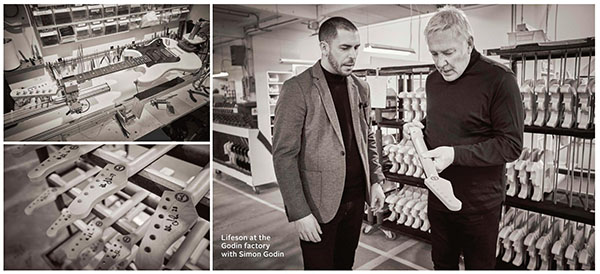 Essentially you were looking to create
a superstrat, similar to what Eddie
Van Halen was doing at the time, where
you’re trying to cross a Fender with a
Gibson.
Essentially you were looking to create
a superstrat, similar to what Eddie
Van Halen was doing at the time, where
you’re trying to cross a Fender with a
Gibson.
Yes. Basically it’s the same idea. And with
the Floyd Rose, too. So now you’ve got a
consistent vibrato system that stays in tune.
And we’re going to offer two different versions
— one with the [locking] Floyd Rose
and then one that’s just a straight-through.
It’s not a lockdown. Because not everybody
goes crazy with that thing. I actually
like to use the arm pretty subtly — more as a
vibrato instead of to do big dive bombs and
things like that. And sometimes it’s a little
cumbersome with the locking nut. So we thought we would just make that an option
available to people. But the guitar sounds
great, and it’s really playable. The neck feels
really, really good on it, too. You know, I
took all the finish off the neck and made it
really personal to what I like, and Godin
really did it right.
Over the years you’ve collaborated with
various manufacturers on signature guitars
and amplifiers. In the past, artists
would generally stay with one company,
but nowadays it seems like there’s less of
an issue with collaborating with multiple
brands. Is this something that has ever
been a problem for you?
It hasn’t been an issue. For the guitar, we
approached Godin, a Canadian company,
and I liked that. I like to keep stuff at home
if I can. They were very enthusiastic, and
we spent a lot of time going back and forth
on exactly what the design is, if there’s any
compromises we had to make on the design
for considerations of copyright and all of
that. They were really into the project and
they continue to be. So at the end of the day,
it all worked and everybody’s fine with it.
For longtime Rush fans, one of the most
exciting aspects of all this new gear is the
possibility of getting closer to achieving
the Alex Lifeson-like tones that they’ve
loved all these years. In your opinion,
what is that Alex Lifeson tone?
Wow, that’s hard for me to answer. I don’t
know how people hear my sound or my
tone. I strongly believe that if you give a
guitar to five different players — same guitar,
same amp — each one of them is going
to sound different, just because of the way
they play. The attack, how their fingers
move, all of that. A lot of it is your own personal
mojo that goes into your playing. To
try and be a little objective. I guess when
people think of my tone, they think of clean
arpeggios, so that needs to be addressed.
And they think of a solid, crunchy sound.
I’m not overly heavy, not metal-y in that
sense. I like to have definition and clarity
in whatever it is I’m doing, whether it’s
a heavy, dirty sound or it’s a clean sound
with body. And I want the gear I’m using to
respond and speak well to that. Those are
maybe the types of things people hear when
they listen to my playing.
Speaking of your playing, is there
any possibility you might put all this
great new gear to work alongside
Geddy?
Um… Don’t know. [Laughs] Really, there’s
so much stuff in the airwaves these days
about Geddy and I getting back together
and doing something. And I think it’s partly
because of the way things went nine years
ago, when we finished touring. We were
at a high point, and we were playing really
well. The show looked great. I think a lot of
our fans felt, you know, why now? But we
broke up the band basically for Neil. And he
had valid reasons. He was tired. He couldn’t
play at the level he demanded from himself.
So he felt it was time. But I think that
for a lot of Rush fans there wasn’t a feeling
of closure. So there’s a hope that we’d get
back together.
I will say that doing this book tour with
Geddy [for Lee’s 2023 memoir, My Effin’
Life], I did a few of the stops with him, and
it’s kind of reignited interest in us getting
out and playing. And the shows that we did
last year for Taylor Hawkins [at the 2022
Taylor Hawkins Tribute Concerts] were
inspiring, too. So for a little while I thought,
you know, it’d be kind of good to get back
out. And then I thought… nah, not really.
[Laughs] I mean, we toured for 40 years.
I’m not interested in going back out on tour.
I don’t wanna sit in a hotel room for hours
and hours and hours to work for a couple
of hours. Been there, done it, loved it. But
that’s in the past. So whether Ged and I get
back together again and write or do anything,
we’ll see. Until then, there’s plenty to
work on, you know?
RUSH Grace Under Pressure
ALEX LIFESON RECALLS THE MAKING OF THE BAND’S “REALLY DIFFICULT” 10TH ALBUM
By Richard Bienstock
NINETY-EIGHTY-FOUR
saw Rush release their 10th
studio album in as many
years. But while the trio — guitarist
Alex Lifeson, bassist, keyboardist
and singer Geddy Lee and drummer
and lyricist Neil Peart — were firmly
established as rock superstars, they
were also in some ways operating as
a newborn act, exploring uncharted,
sometimes, uneasy rock territory.
Following the massive mainstream
success of 1981’s Moving Pictures,
which spawned now-classic singles
like “Limelight,” Freewill” and “Tom
Sawyer,” the band took a hard turn
on the next year’s Signals, which
pushed synthesizers to the forefront,
relegating Lifeson’s guitar to a less
central and more supportive role.
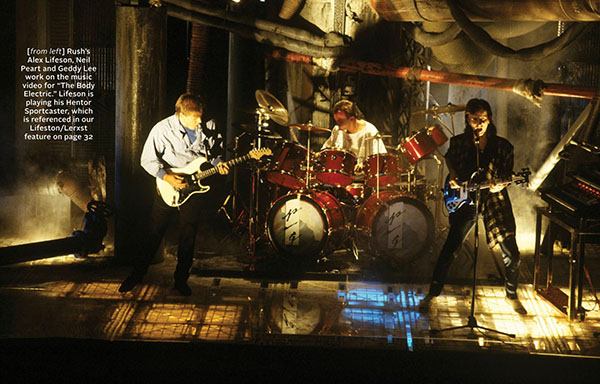 “Signals was a weird record for
me — I liked the songs, but I thought it was a little weak in tonality,” Lifeson
tells Guitar World. “Keyboards
started coming up a lot more and so
there was a little more of a fight for
space with the guitar, which would
continue with some of the following
records.” The band’s next album,
Grace Under Pressure, “was kind of
a response to Signals,” Lifeson says,
“and it became more of a guitar
record.”
“Signals was a weird record for
me — I liked the songs, but I thought it was a little weak in tonality,” Lifeson
tells Guitar World. “Keyboards
started coming up a lot more and so
there was a little more of a fight for
space with the guitar, which would
continue with some of the following
records.” The band’s next album,
Grace Under Pressure, “was kind of
a response to Signals,” Lifeson says,
“and it became more of a guitar
record.”
Indeed, while Grace Under Pressure, released April 12, 1984, still sounds closer to the
synthy, heavily processed sound of Signals than the rock
anthems of Moving Pictures, Lifeson’s guitar is more
present throughout, spiking the tracks with driving riffs
and slashing chord work, and infusing songs like “Afterimage,”
“Between the Wheels” and “The Body Electric”
with characteristic hot-wired solos. “I think ‘The Body
Electric’ is my favorite song from the record,” Lifeson
says. “I really liked the solo on that one.”
Gear-wise, Lifeson employed a combination of Marshall
and Carvin amps in the studio and relied heavily on a Loft digital delay unit and a DeltaLab HarmoniCom-puter harmonizer (which you can hear it on “Distant
Early Warning” and “Red Sector A”), among other
effects. His main guitars for the sessions, which took
place at Le Studio in Quebec, were his white Hentor
Sportscaster, as well as another Strat similarly modified
with a humbucker in the bridge position, along with his
trusty Gibson ES-355. “I liked the combination of the
355 double-tracking with a Tele or a Strat — something a
little wiry, with a different character,” he says. “That was
sort of my go-to.”
Despite the high quality of the songs and performances,
Lifeson concedes that Grace Under Pressure was a “really
hard” record to make. “We started working on it with
[producer] Steve Lillywhite,” he says. “We approached
him on the previous tour and we agreed to work together
on Grace Under Pressure. But then literally last minute
we got a call from his management and they said, ‘Steve’s
taken another project. He won’t be doing your project.’
That really left us in a lurch.”
In a pinch, the band went searching for a new producer
and landed on Peter Henderson, who had worked
with Jeff Beck, Paul McCartney and Wings, Supertramp and others. “Peter had a good track
record, but while he was qualified,
he just didn’t seem to be focused,”
Lifeson says. “That left it up to
the three of us to really focus on
production. We like to work with a
producer that’s sort of like the fourth
wheel, where we do what we do and
they add just a little bit of direction
and deal with some of the stuff we
don’t want to deal with. That way we
can focus directly on the music. But
that wasn’t quite the case. I remember
we were at Le Studio and it was a very, very cold winter. The record
took a long time to make and it was
really, really difficult.”
That said, he adds, “When it was
all said and done we were quite
proud of it. I like the tone of the record.
I like the songs on that record.
I think that it was a progression
from the previous records, and that’s
what we always wanted to achieve.”
Throughout Rush’s decades together,
Lifeson continues, “We always
wanted to move forward. With Grace
Under Pressure we certainly did.”
-| Click HERE for more Rush Biographies and Articles |-

